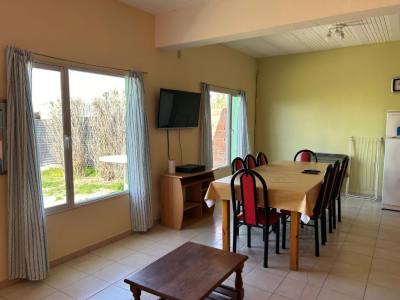
In the rooms of the Rada Tilly Regional Museum, we learned about the life of the first dwellers of Patagonia. Besides, we saw a replica of the Cave of Felines.
Inaugurated on February 27, 1987, the Rada Tilly Regional Museum is the result of an uneasy spirit among the neighbors of
the seaside district, who with enthusiasm and dedication resolved to create it in order to preserve the heritage of the region. The collections displayed at the various chambers were created with a series of tasks aimed in the same direction: rescuing, preserving, appreciating and spreading the historical and cultural heritage of the region. At present, the Rada Tilly Regional Museum has a collection of 10,000 pieces very well distributed in order to be appreciated by tourists interested in learning about the roots of this zone in the country.

The tour starts at the Paleontology room. It shelters the most ancient vestiges of the Patagonian environmental system. A board displays the geological eras and the evolution of life on Earth. Its glass cabinets exhibit sea and land fossils. The visit continues in the Archeology and ethnic history room, where visitors may appreciate the lithic instruments made by groups of hunters and gatherers who dwelled on Patagonian soil ever since 13,000 years ago until approximately the XVI century. The third room of the museum contains the local flora and fauna. Sea and land ecosystems reproduce the natural environment of the southern coastline and high plateau.

At the end of the tour, there is a unique opportunity to access a room attached to the museum where the sensation of entering the famous “Cave of Felines" may be experienced. The original cave is located in the central high plateau in the Province of Santa Cruz. It is worth a visit.
The Cave of Felines
The original cave is located in the area known as
Cañadón de las Cuevas (the Caves Ravine), in the central high plateau in the Province of Santa Cruz, 180 kilometers away from Gobernador Gregores. It represents a natural geological formation whose walls have been used by prehistoric painters to portray their works.

Inside the cave, a matchless work may be observed: the silhouettes of four felines, two on each wall, which might be jaguars, according to their shape and colors. On the background wall in the cave, there is also a polychromatic frieze of great dimensions, where undulated and negative motifs of hands have been painted in white, black and red; left hands of several sizes dominate the scene, including children's hands. If there is no possibility to access the cave itself, the Rada Tilly Regional Museum invites visitors to see a scale reproduction of this wonderful original site. Visiting the museum is a very enriching experience. The politeness of the museum staff, along with the good organization of the material, makes it worth a visit during your stay at the seaside district.




























